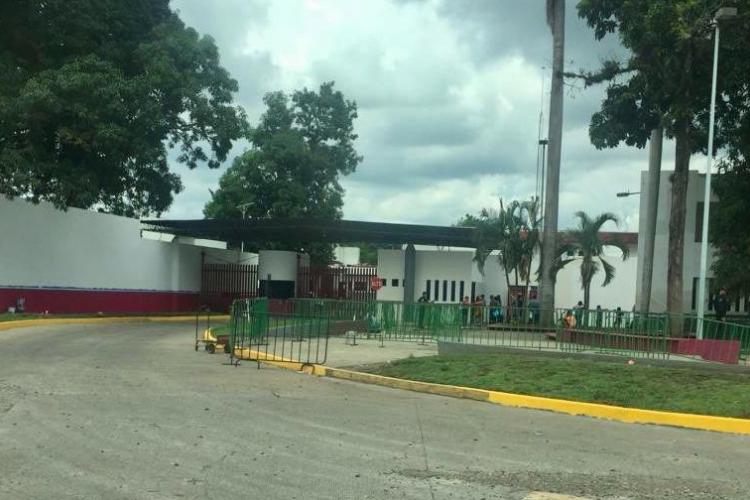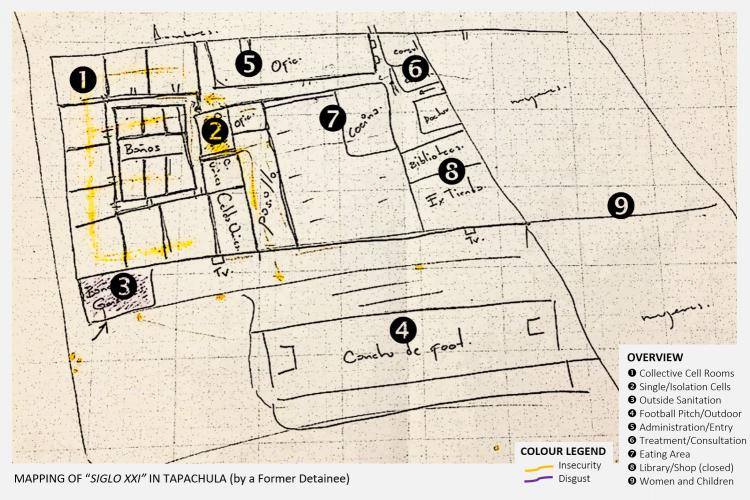Guest post by Julia Manek and David Tobasura Morales. Julia is a Researcher in Clinical Psychology and Human Geography at Goethe-University Frankfurt, and a Member of the Colectivo Contra la Tortura y la Impunidad (CCTI). David is a Sociologist and Program Officer at the American Friends Service Committee (ASFC). Both authors are part of the Mexican Grupo Impulsor Contra la Detención Migratoria y la Tortura (Grupo Impulsor). This is the second post from our new series on 'Expanding the penal landscape', organised by Ana Ballesteros-Pena.

Instead of guaranteeing human rights for those who seek protection, national states create deadly geographies: migrants are immobilized, forced to return, or left to die. One of the symptoms of this white supremacist regime of deterrence is the increased use of migration detention centres. Along the borders of both arrival and transit states, detention creates a state of mental, physical and social injury. In this blog post, we argue that these devastating conditions and inhumane treatment that flight migrants face in immigration detention centres can be declared as “torturous”.
According to the Convention Against Torture (CAT), torture is the intentional infliction of severe pain or suffering on a powerless victim, usually a detainee, for a specific purpose, such as for the extraction of a confession or information or else for their intimidation or punishment, committed by a public official. However, what if this infliction of suffering is not committed by a public official, but caused by the architecture, the infrastructure or topography of the detention centre? Unlike the CAT, the European Court of Human Rights (ECHR) chose not to define torture rigidly, emphasizing that what constitutes “torture” is expected to differ over time. While the legal definition of torture is in dispute, the psychological effects of torture – and its intention – are not.
Documenting torture and human rights violations in Estaciones Migratorias
The Mexican migration detention centres are called estaciones migratorias. Yet, the legal definition in Mexican migration law differs from a conceptualization as detention facilities. Since it came into force in 2011, the law decriminalized undocumented border crossing and considered it an administrative misconduct that does not result in any legal sanctions. The estaciones migratorias were created by the Mexican government with the intention of "presenting" - "accommodating" - irregular migrants for committing an administrative (not criminal) offence and resolving their irregular migratory situation - either through regularisation or deportation them. However, organisations (e.g. Sin Fronteras, CCTI, Centro de Derechos Humanos Fray Matías de Córdova) and state actors have pointed at practices of torture and other cruel inhuman or degrading treatment or punishment (TCIDT) in these facilities. In 2019, before the outbreak of the pandemic and the decrease of detention, detention numbers surpassed 180,000 cases.
The collaborative investigation and documentation project of the Grupo Impulsor explores these facilities and the human rights violations that occur inside them through expert interviews, based on the documentation with the Torturing Environment Scale (TES) and countermappings. Drawing on this methodology, the project aims to visualize patterns of abuse that are independent of place and year in the detention regime. In the estaciones migratorias, detainees are systematically mistreated. They suffer discrimination, threats and punishment, compounded by rotten or iodized food, extreme temperatures, lack of water and overcrowding. The inhuman conditions, the manipulation of infrastructure and architecture, enforced by the guards’ degrading treatment, form a torturing environment. Together with exposure to other detainees’ mental distress, self-harm and suicide, a torturous space emerges that hinders reciprocal social relations and maintains detainees in a necropolitical state of injury.
As said in the beginning, this scenario is not specific to the Mexican immigration detention centres. It reaches beyond national and continental borders and seemingly manifests itself in all regions of the world, as recently documented in the EU’s hotspot camp “Moria” on Lesvos.
A tentative horizon: further conceptual work
The concepts of torturing environments and torturous spaces challenge the perception of torture as directed foremost against physical integrity. Instead, it might not leave physical marks, while having a severe impact on the detainees' mental health and social relations. Children are especially likely to develop new mental – but also physical – health difficulties in detention. Symptoms of torture survivors are similar to symptoms of human beings who were exposed to migration detention: feelings of depression, anxiety, hopelessness and a high prevalence of posttraumatic stress disorder (PTSD) prevail.
Yet, the CAT clings to its definition of torture as being something that is intentionally inflicted upon someone: Is a “torturous space” produced with “torturous intentions”? Is it possible to prove a state’s intentions to punish any person detained in refugee campsites if this very state rejects such an assumption and hides behind remoteness and human rights discourses, as postcolonial states often do?
The impact of immigration detention is undoubtedly harsh. Nevertheless, (supra‑)national actors invest billions in securitization and surveillance politics – but not in the dignity of human life.
We should dedicate further effort to the elaboration of the concept of torturing environments and/or torturous spaces: While they derive from existing frameworks of torture, they are not “equal” to torture. It is important to establish analytical differences in order not to blur the concept of torture or trivialize it. We must handle the concept torturous space with care due to the stigma that often goes along with having survived torture. Yet, the concept acknowledges the detainees as subjects of rights – instead of disenfranchised beings and/or objects of humanitarian aid.
“Language is very important because the government created some terms and concepts. And unfortunately, all other actors use the language of the government. So, the government says that, ‘Oh, this place is an offshore processing centre’. But in fact, it’s not that. Some of the refugees created another term. […] they called them ‘offshore processing torture’. I think these words are very powerful.”

Abolitionist futures?
Our documentation study concentrates on the psychosocial impacts and the geographical issue of space. Generally, the documentation of torture as foreseen by the Istanbul Protocol includes a psychological, medical and legal expert opinion. Further differentiation in the legal conceptualization is needed to build a future horizon for social and spatial justice.
Being "torturous spaces", the estaciones migratorias and other forms of migration detention and campsites as such must be abolished. Yet, domination and suppression do not vanish, but merely change their forms. After years of careful documentation and fierce political work against the detention of children, migration detention of children has been officially banned in Mexico. The so-called "alternatives" to detention have been put into play and are turned into a means of criminalizing solidarity activists and shelters. Meanwhile, the supposed alternatives preserve state control over migrants, without guaranteeing options for regularization. Therefore, from an abolitionist perspective, the only “alternative to detention” is non-detention.
Any comments about this post? Get in touch with us! Send us an email, or post a comment here or on Facebook. You can also tweet us.
__________
How to cite this blog post (Harvard style)
Manek, J. and Tobasure Morales, D. (2022) Estaciones Migratorias, Torturing Environments, Torturous Spaces. Available at: https://www.law.ox.ac.uk/research-subject-groups/centre-criminology/centreborder-criminologies/blog/2022/01/estaciones [date]
Share:








